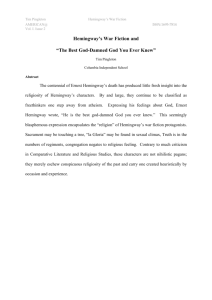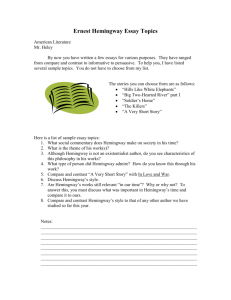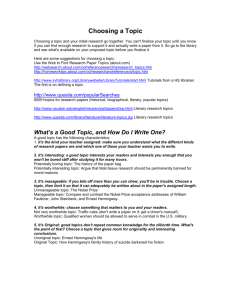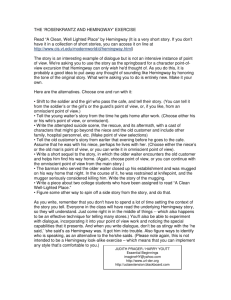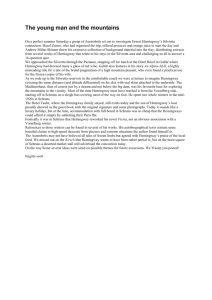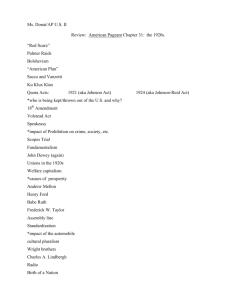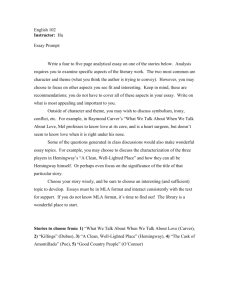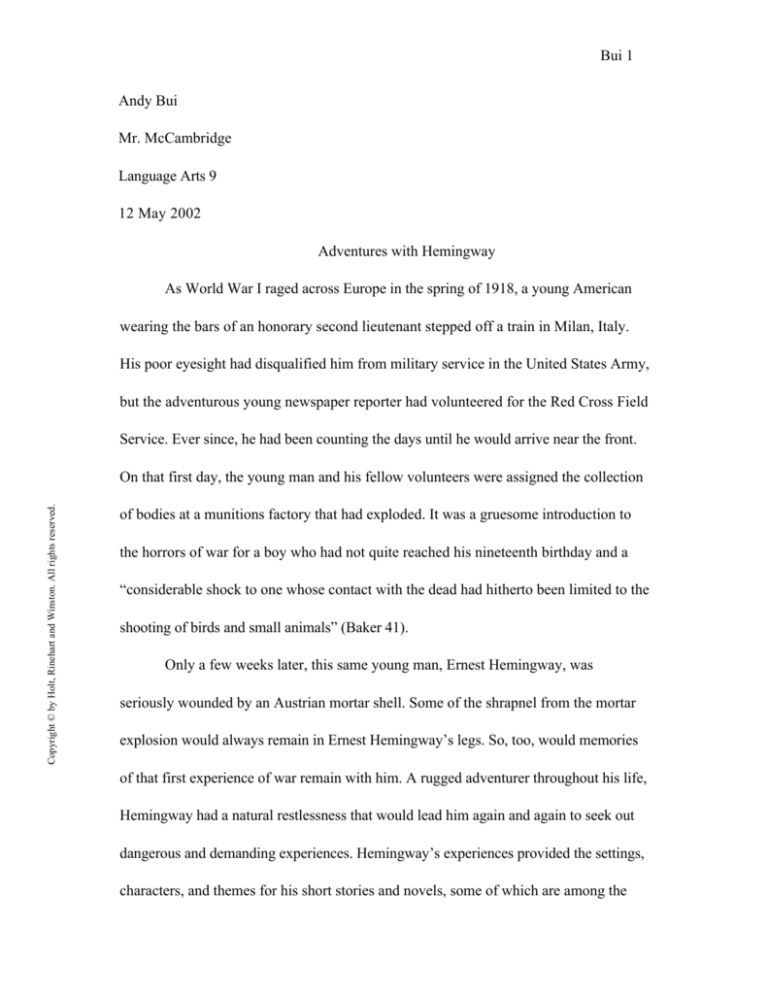
Bui 1
Andy Bui
Mr. McCambridge
Language Arts 9
12 May 2002
Adventures with Hemingway
As World War I raged across Europe in the spring of 1918, a young American
wearing the bars of an honorary second lieutenant stepped off a train in Milan, Italy.
His poor eyesight had disqualified him from military service in the United States Army,
but the adventurous young newspaper reporter had volunteered for the Red Cross Field
Service. Ever since, he had been counting the days until he would arrive near the front.
Copyright © by Holt, Rinehart and Winston. All rights reserved.
On that first day, the young man and his fellow volunteers were assigned the collection
of bodies at a munitions factory that had exploded. It was a gruesome introduction to
the horrors of war for a boy who had not quite reached his nineteenth birthday and a
“considerable shock to one whose contact with the dead had hitherto been limited to the
shooting of birds and small animals” (Baker 41).
Only a few weeks later, this same young man, Ernest Hemingway, was
seriously wounded by an Austrian mortar shell. Some of the shrapnel from the mortar
explosion would always remain in Ernest Hemingway’s legs. So, too, would memories
of that first experience of war remain with him. A rugged adventurer throughout his life,
Hemingway had a natural restlessness that would lead him again and again to seek out
dangerous and demanding experiences. Hemingway’s experiences provided the settings,
characters, and themes for his short stories and novels, some of which are among the
Bui 2
best-known works of American literature.
The United States had only recently entered World War I when Ernest
Hemingway graduated from high school. Like many young men of his time, the
eighteen-year-old had visions of war as a romantic adventure and, according to his
brother, “wanted to go to war more than anything in the world” (Hemingway 44). When
his father refused permission for Ernest’s immediate enlistment, young Hemingway
sought to gain experience and freedom as a reporter on the police beat of the Kansas
City Star. In his six months at the Star, he learned to write in the clipped, matter-of-fact
style that would characterize his fictional works, and he waited for his father to give in
and give him permission to go to Europe, which he did shortly after Christmas in 1917.
Copyright © by Holt, Rinehart and Winston. All rights reserved.
When Hemingway learned that he could not serve in the military, he “decided
that the American Red Cross Field Service would give the best chance to see the most
action” (Hemingway 45). Although Hemingway could not serve as a soldier himself, on
his return to the United States he was—for a while, at least—treated as a war hero
because of his wound. He gave talks to local groups and had articles about his bravery
under enemy fire published in the local newspaper; he often exaggerated details of his
exploits to delight his audience.
The experience of World War I—and the stories Hemingway and others built
around it—became part of the Hemingway legend as fact and fiction. “Hemingway’s
wounding along the Piave River in Italy and his subsequent recovery at a hospital in
Milan, including the relationship with his nurse Agnes von Kurowsky, all inspired his
great novel A Farewell to Arms” (“Ernest Hemingway Biography”).
Bui 3
After his wartime service in Italy, Hemingway returned to Illinois. Later, he
went to the family home in Michigan, where he enjoyed solitary walks in the woods
and fishing trips and wrote articles for the Weekly Star magazine and the Toronto Star
(Hemingway 60–61). After Hemingway married in 1921, wanderlust struck again, and
he took his new bride to Europe. There, Hemingway “worked on his fiction, and
blossomed under the guidance of [fellow expatriates] [Gertrude] Stein, [Ford Madox]
Ford, Ezra Pound, F. Scott Fitzgerald, and James Joyce” (“A Hemingway
Retrospective”). He also wrote feature articles on European politics and developed a
passion for bullfighting. In Our Time, a collection of short stories, was published twice
during this period, one version in 1924, another in 1925.
Copyright © by Holt, Rinehart and Winston. All rights reserved.
But there seemed to be a collective effort by Hemingway’s many writermentors to witness the birth of his first novel. It came in 1926, and Hemingway’s
life would never be the same. The Sun Also Rises was an international success.
The story, based on Hemingway’s own experiences, chronicled a group of
American expatriates living in Paris who travel to Pamplona, Spain, for the San
Fermin Festival, or “the running of the bulls” (“A Hemingway Retrospective”).
At the young age of twenty-eight, Ernest Hemingway had become a rising literary star
(“Tracking Hemingway”).
Although his life would be marred by tragedy and conflict more than once—his
father died in 1928, and three of his four marriages ended in divorce—he would never
seek the quiet writer’s life. Instead, Hemingway’s constant need for excitement and
physical challenge would lead him to serve as a correspondent in both the Spanish Civil
Bui 4
War and World War II, to travel to Africa on a hunting safari, and to take up sport
fishing in Cuba. All of Hemingway’s real-life experiences eventually found their way
into his fictional works, including the novel For Whom the Bell Tolls, set in Spain
during the civil war; the famous short story “The Snows of Kilimanjaro,” set in Africa;
and the novel The Old Man and the Sea, based on his experiences in Cuba. For The Old
Man and the Sea, Hemingway won the Pulitzer Prize in 1952 (Baker 510). Finally, in
1954, Hemingway received the Nobel Prize in literature. “It was the high point of
Hemingway’s writing career, ensuring his legacy for generations to come” (“A
Hemingway Retrospective”).
The young reporter who had gone to war in search of glory certainly had found
Copyright © by Holt, Rinehart and Winston. All rights reserved.
it. Throughout his life, he continued to seek—and find—experiences that would push
him to the limits of physical and emotional endurance—in Europe, in Africa, in Cuba,
during war and peace. For Hemingway, it seemed that life was most real at its most
dangerous edges. His experiences gave him great material for his stories and novels.
Many of the people Hemingway knew became characters in his works. Almost
everything he did was an adventure to be written. Along the way, Hemingway the
writer became Hemingway the legend. Today, the Hemingway myth is still strong, but
as Michael Reynolds noted on the centennial of Hemingway’s birth, “By the time
we’ve reached the centennial [. . .] he’s been reduced to generalizations and clichés. [. . .]
But the fiction [. . .] if he didn’t write anything, we wouldn’t remember him” (qtd. in
“A Hemingway Retrospective”).
Bui 5
Works Cited
Allen, Jamie. “A Hemingway Retrospective.” CNN.com. 1999. Cable News Network
27 February 2002 <http://www.cnn.com/SPECIALS/books/1999/hemingway/
stories/biography/index.html>.
Baker, Carlos Heard. Ernest Hemingway: A Life Story. New York: Charles Scribner’s
Sons, 1969.
Hemingway, Leicester. My Brother, Ernest Hemingway. Cleveland: The World
Publishing Company, 1962.
“Ernest Hemingway Biography.” The Hemingway Resource Center. 27 February 2002
<http://www.lostgeneration.com/ww1.htm>.
Copyright © by Holt, Rinehart and Winston. All rights reserved.
“Tracking Hemingway.” The Atlantic online. 27 February 2002
<http://www.theatlantic.com/unbound/ flashbks/hemingway.htm>.

